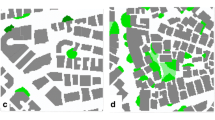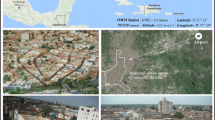Abstract
The design characteristics of street canyons were investigated in Guangzhou in the hot-humid area of China, and the effects of the design factors and their interactions on pedestrian thermal comfort were studied by numerical simulations. The ENVI-met V4.0 (BASIC) model was validated by field observations and used to simulate the micrometeorological conditions and the standard effective temperature (SET) at pedestrian level of the street canyons for a typical summer day of Guangzhou. The results show that the micrometeorological parameters of mean radiant temperature (MRT) and wind speed play key roles in pedestrian thermal comfort. Street orientation has the largest contribution on SET at pedestrian level, followed by aspect ratio and greenery, while surface albedo and interactions between factors have small contributions. The street canyons oriented southeast-northwest or with a higher aspect ratio provide more shade, higher wind speed, and better thermal comfort conditions for pedestrians. Compared with the east-west-oriented street canyons, the north-south-oriented street canyons have higher MRTs and worse pedestrian thermal comfort due to their wider building spacing along the street. The effects of greenery change with the road width and the time of the day. Street canyon design is recommended to improve pedestrian thermal comfort. This study provides a better understanding of the effects of street canyon design on pedestrian thermal comfort and is a useful guide on urban design for the hot-humid area of China.







Similar content being viewed by others
References
Acero JA, Herranz-Pascual K (2015) A comparison of thermal comfort conditions in four urban spaces by means of measurements and modelling techniques. Build Environ 93(1):245–257
Ali-Toudert F, Mayer H (2006) Numerical study on the effects of aspect ratio and orientation of an urban street canyon on outdoor thermal comfort in hot and dry climate. Build Environ 41(2):94–108
Ali-Toudert F, Mayer H (2007) Effects of asymmetry, galleries, overhanging façades and vegetation on thermal comfort in urban street canyons. Sol Energy 81(6):742–754
Bruse M, Fleer H (1998) Simulating surface–plant–air interactions inside urban environments with a three dimensional numerical model. Environ Model Softw 13(384):373
DHURDG (Department of Housing and Urban-Rural Development of Guangdong Province) (2006) Design standard for energy efficiency of residential buildings in hot summer and warm winter zone of China - application regulations for Guangdong province. DBJ 15–50. Guangzhou, China. (in Chinese)
Erell E, Pearlmutter D, Boneh D, Kutiel PB (2013) Effect of high-albedo materials on pedestrian heat stress in urban street canyons. Urban Climate 10:367–386
Gagge AP, Fobelets AP, Berglund LG (1986) A standard predictive index of human response to the thermal environment. ASHRAE Trans 92:709–731
Holst J, Mayer H (2011) Impacts of street design parameters on human- biometeorological variables. Meteorol Z 20(5):541–552
ISO (1998) Ergonomics of the thermal environment e instruments for measuring physical quantities. International Standard 7726. Geneva: ISO
Johansson E, Emmanuel R (2006) The influence of urban design on outdoor thermal comfort in the hot, humid city of Colombo, Sri Lanka. Int J Biometeorol 51(2):119–133
Johansson E, Spangenberg J, Gouvêa ML, Freitas ED (2013) Scale-integrated atmospheric simulations to assess thermal comfort in different urban tissues in the warm humid summer of São Paulo, Brazil. Urban Climate 6(6):24–43
Lee H, Holst J, Mayer H (2013) Modification of human-biometeorologically significant radiant flux densities by shading as local method to mitigate heat stress in summer within urban street canyons. Adv Meteorol:1–13
Lee H, Mayer H, Schindler D (2014) Importance of 3-D radiant flux densities for outdoor human thermal comfort on clear-sky summer days in Freiburg, Southwest Germany. Meteorol Z 23(3):315–330
Lee H, Mayer H, Chen L (2016) Contribution of trees and grasslands to the mitigation of human heat stress in a residential district of Freiburg, Southwest Germany. Landsc Plan 148:37–50
Li D (2001) General principles of urban planning. China Architecture & Building Press, Beijing (in Chinese)
Lobaccaro G, Acero JA (2015) Comparative analysis of green actions to improve outdoor thermal comfort inside typical urban street canyons. Urban Climate 14:251–267
Mayer H, Höppe P (1987) Thermal comfort of man in different urban environments. Theor Appl Climatol 38(1):43–49
Mayer H, Holst J, Dostal P, Imbery F, Schindler D (2008) Human thermal comfort in summer within an urban street canyon in Central Europe. Meteorol Z 17(3):241–250
MOHURD (Ministry of Housing and Urban-Rural Development of the People’s Republic of China) (2013) Design standard for thermal environment of urban residential areas. JGJ 286. China Architecture & Building Press, Beijing (in Chinese)
Nakano J, Tanabe SI (2004) Thermal comfort and adaptation in semi-outdoor environments. ASHRAE Trans 110(2):543–553
Ndetto EL, Matzarakis A (2013) Effects of urban configuration on human thermal conditions in a typical tropical African coastal city. Adv Meteorol 2013(2):157–160
Pearlmutter D, Berliner P, Shaviv E (2006) Physical modeling of pedestrian energy exchange within the urban canopy. Build Environ 41(6):783–795
SCUT (South China University of Technology) (2003) Building physics. South China University of Technology Publishing House, Guangzhou (in Chinese)
Sharmin T, Steemers K, Matzarakis A (2015) Analysis of microclimatic diversity and outdoor thermal comfort perceptions in the tropical megacity Dhaka, Bangladesh. Build Environ 96(96):118–122
Taguchi G, Konishi S (1987) Orthogonal arrays and linear graphs. MI, AI press, Dearborn
Taleghani M, Kleerekoper L, Tenpierik M, Dobbelsteen AVD (2015) Outdoor thermal comfort within five different urban forms in the Netherlands. Build Environ 83:65–78
Taleghani M, Sailor D, Ban-Weiss GA (2016) Micrometeorological simulations to predict the impacts of heat mitigation strategies on pedestrian thermal comfort in a Los Angeles neighborhood. Environ Res Lett 11(2):1–12
Wang Z (2008) Design strategies for the climate adaptability of street canyon based on urban microclimate in hot-summer and cold-winter zone. Huazhong University of Science & Technology. (in Chinese)
Willmott CJ (1982) Some comments on the evaluation of model performance. Bull Am Meteorol Soc 63:1309–1369
Xi T, Li Q, Mochida A, Meng Q (2012) Study on the outdoor thermal environment and thermal comfort around campus clusters in subtropical urban areas. Building & Environment 52(6):162–170
Zhai Y, Jin L, Meng Q, Zhang Y, Zhao L (2009) A field study of thermal comfort in outdoor environment in Guangzhou, China. In: Paper presented at the Proceedings of the 6th international symposium on heating, ventilating and air conditioning. China, Nanjing
Zhao J, Liu J (2007) Numerical simulation and designs of thermal environments of urban street canyons. Architectural Journal 3:37–39
Acknowledgements
The work was supported by the Fundamental Research Funds for the Central Universities.
Author information
Authors and Affiliations
Corresponding author
Electronic supplementary material
ESM 1
(DOCX 443 kb)
Rights and permissions
About this article
Cite this article
Zhang, Y., Du, X. & Shi, Y. Effects of street canyon design on pedestrian thermal comfort in the hot-humid area of China. Int J Biometeorol 61, 1421–1432 (2017). https://doi.org/10.1007/s00484-017-1320-6
Received:
Revised:
Accepted:
Published:
Issue Date:
DOI: https://doi.org/10.1007/s00484-017-1320-6




